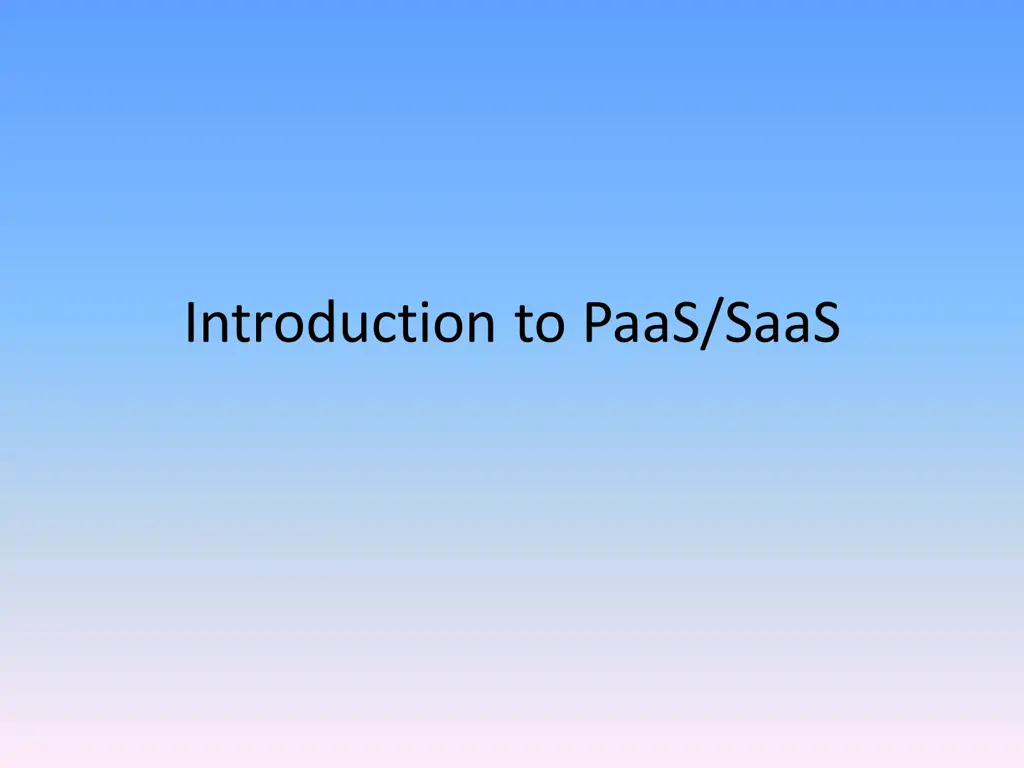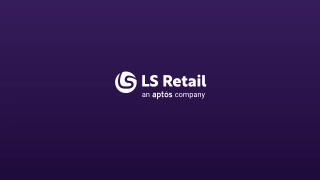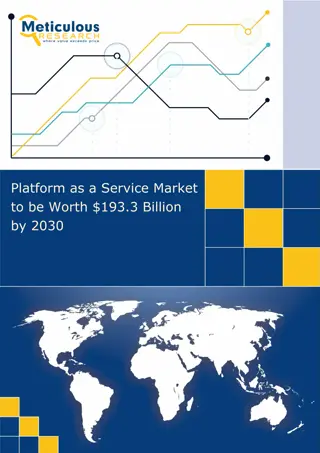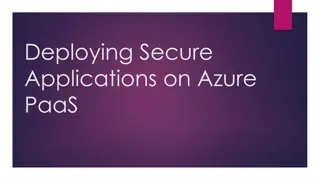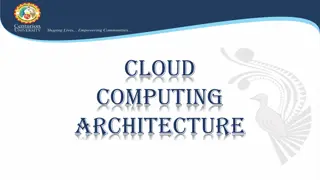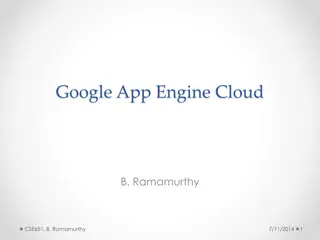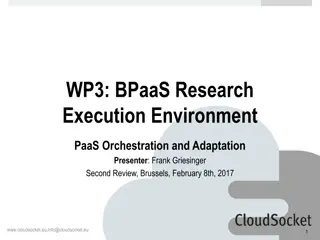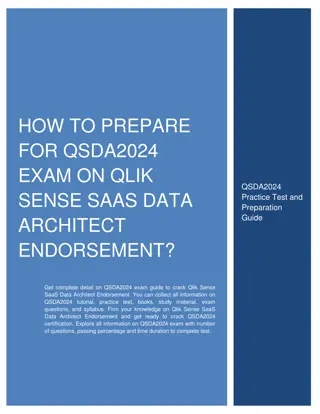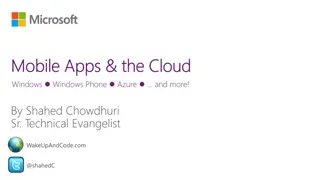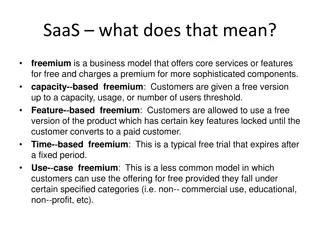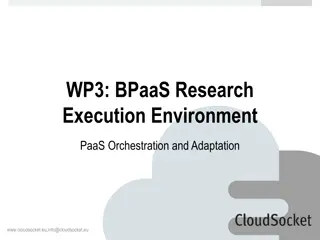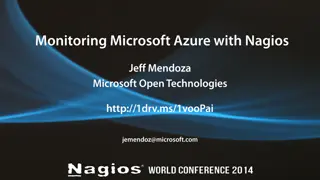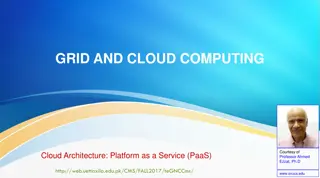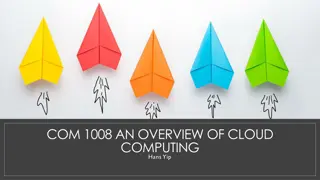Introduction to PaaS/SaaS
An overview of Platform as a Service (PaaS) and Software as a Service (SaaS) in cloud computing.
Download Presentation

Please find below an Image/Link to download the presentation.
The content on the website is provided AS IS for your information and personal use only. It may not be sold, licensed, or shared on other websites without obtaining consent from the author.If you encounter any issues during the download, it is possible that the publisher has removed the file from their server.
You are allowed to download the files provided on this website for personal or commercial use, subject to the condition that they are used lawfully. All files are the property of their respective owners.
The content on the website is provided AS IS for your information and personal use only. It may not be sold, licensed, or shared on other websites without obtaining consent from the author.
E N D
Presentation Transcript
Perspectives Platform as a Service (PaaS) Cloud-based User Applications Utility Computing
Cloud Computing-What is it? moving services, computation and to an internal or external, centralized facility or contractor. Reason easy and ubiquitous accessibility cost collaboration, integration, and analysis on a shared common platform.
What is it? SLAs Web Services Virtualization
What is it? SaaS (software-as-a-service). WAN-enabled application services (e.g., Google Apps, Salesforce.com, WebEx) PaaS (platform-as-a-service). Foundational elements to develop new applications (e.g., Coghead, Google Application Engine) IaaS (infrastructure-as-a-service). Providing computational and storage infrastructure in a centralized, location-transparent service (e.g., Amazon)
What is it? Green indicates the levels owned and operated by the organization Red levels are run and operated by the service provider
Source: http://www.katescomment.com/iaas- paas-saas-definition/
Core Stacks Source: Goel, Pragati, and Mayank Kumar. "An overview of Cloud Computing."
Resource Layer infrastructure layer which is composed of physical and virtualized computing, storage and networking resources. Platform Layer computing framework manages the transaction dispatching and task scheduling. storage sub-layer provides storage and caching capability Application Layer general application logic either on-demand capability or flexible management. no components will be the bottle neck of the whole system. large and distributed transactions and management of huge volume of data. All the layers provide external service through web service or other open interfaces.
What is a Platform? A platform is anything you can leverage to accomplish something in a simpler, faster, or otherwise better way than you could without. As a programmer, you leverage pre-existing code rather than starting from scratch and writing everything. The most well-known software platforms for desktop software are Windows and Mac OS
Web Platforms the infrastructure or hosting layer is analogous to desktop computer hardware and the platform layer is analogous to a desktop operating system. Additional features such as email distribution lists, contact form handlers, e-commerce options and other tools that make it easier to build and run a website are part of almost every hosting service,
Goals of PaaS The ultimate goal of a PaaS is to make it easier for you to run your website or web application no matter how much traffic it gets. You just deploy your application and the service figures out what to do with it. A platform as a service should handle scaling seamlessly for you so you can just focus on your website and the code running it.
Why PaaS? There is always a conflict between the developers and the System Engineers Developers are keen on getting their environments up without waiting. System Engineers care about performance and stability Creates a peaceful environment for both parties
OpenShift The open source PaaS from RedHat OpenShift runs on top of OpenStack Companies can deploy OpenShift on top of their infrastructure OpenStack is the infrastructure and OpenShift is the platform that run on top of it This analogous to Apache and MySQL that run on top of a Linux machine
OpenShift Example What is a cartridge? OpenShift offers cartridges to deploy on to Red Hat s infrastructure Sign up for OpenShift Create your own namespace Deploy Apps Sample cartridges Java, PHP, Ruby, Python Framework support- CakePHP, CodeIgniter
Platform Comparison Google App Engine Amazon Beanstalk CloudBees RUN@Cloud Red Hat OpenShift VMWare CloudFoundry Stratos Heroku Cloud Characteristics Cloud Dimensions Production Ready DevOps activities and phases Cloud Architecture Platform Services 5 7 5 7 3 5 3 3 5 3 3 0 3 3 3 3 3 0 3 7 0 5 5 10 2 7 4 2 3 4 2 3 2 7 3 2 5 3 2 5 3 2 Programming Model 2 5 1 1 1 1 1
SaaS Definition Software as Service is a software delivery model in which software and data are hosted centrally and accessed via web. It can be rented . Configuration and customization according to the customer Accelerated feature delivery weekly updates Multi tenant architecture single instance of the software for multiple client organizations Open integration protocols API S and protocols for accessing company s internal systems
A Brief History 1960-IBM and other main frame providers came up with time sharing or utility computing services. 1990- ASP with advent of internet 2000- Increased speed of internet resulted in more popularity of SaaS
ADVANTAGES USER BENEFITS: Lower Cost of Ownership Focus on Core Competency . Access Anywhere Freedom to Choose (or Better Software) Faster Product Cycles VENDOR BENEFITS: .Increased Total Available Market . Lower Development Costs & Quicker Time-to-Market . Improved Customer Relationships
Applicability and types of SaaS Enterprise Software application: Sharing of data between internal and external users e.g. : Salesforce CRM application Single user Software application Runs on single user computer and serves 1 user at a time e.g. : Microsoft office Business Utility SaaS - Applications like Salesforce automation are used by businesses and individuals for managing and collecting data, streamlining collaborative processes and providing actionable analysis. Popular use cases are Customer Relationship Management (CRM), Human Resources and Accounting. Social Networking SaaS - Applications like Facebook are used by individuals for networking and sharing information, photos, videos, etc.
Important factors for a good design Three key differentiators that separate well-designed SaaS application from a poorly designed one scalability Multi tenant efficient configurable Scaling the application - maximizing concurrency, and efficient use of resources i.e. optimizing locking duration, statelessness, sharing pooled resources such as threads and network connections, caching reference data, and partitioning large databases
Multi-tenancy important architectural shift from designing isolated, single-tenant applications One application instance should accommodate users from multiple other companies at the same time while providing transparency This requires an architecture that maximizes the sharing of resources efficiently across tenants
Configurable - a single application instance on a single server has to accommodate users from several different companies Customizing the application for one customer will change the application for other customers as well. Traditionally customizing an application would mean changes in the code. Each customer must use metadata to configure the way the application appears and behaves for its users. Customers configuring applications must be simple and easy without any extra development or operation costs
Azure Architecture Web role One for each instance of software Access control Definition of users, groups and roles. A pre-built ASP.NET membership provider is included in the training kit. Databases Relational database for core operational data Worker role Autonomous background processing like billing Caching frequently used read-only, user specific, and application resource data in a high-speed distributed in-memory for faster response Blobs Blob storage provides a scalable, resilient way to store terabytes of user data
SaaS Drawbacks Robustness Difference between Google docs and Microsoft office. Privacy Storing all data in cloud prone to hacks Reliability Recovery during server downtime is difficult
References Creeger, M. (2009). Cloud computing: An overview. ACM Queue, 7(5), 3-4. OpenShift www.openshift.com http://www.slideshare.net/cobiacomm/introd uction-topaa-s http://www.ibm.com/developerworks/trainin g/kp/cl-kp-cloudsaas/
